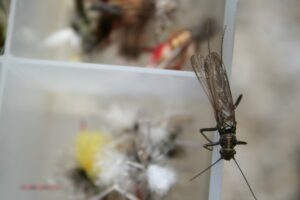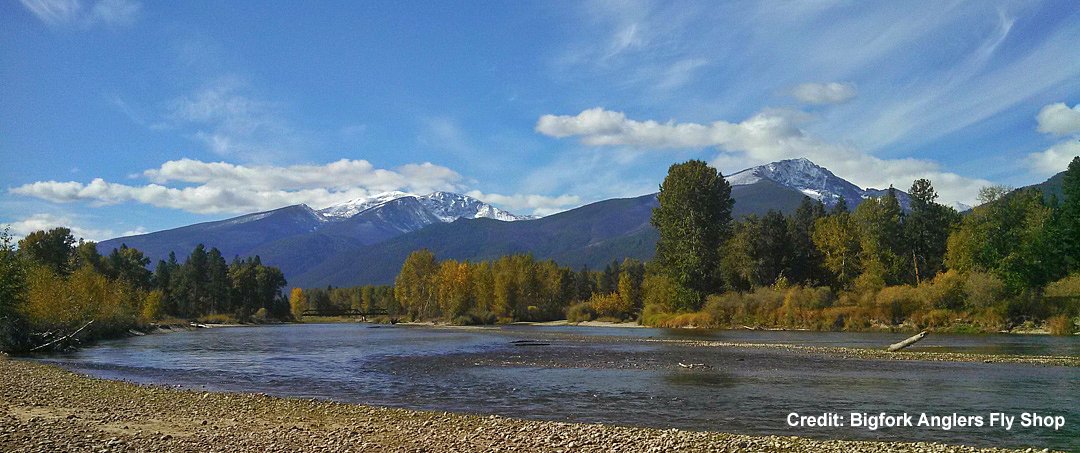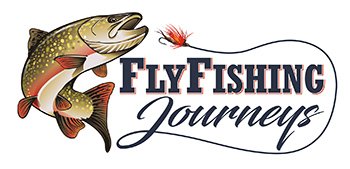The Bitterroot River is my home water. Born and raised in Montana I have fished the Bitterroot for over 30 years, 18 of which I have spent at Water Master Rafts. The river begins at the confluence of the East Fork Bitterroot and the West Fork Bitterroot near Connor, Montana. From there it flows North through the scenic Bitterroot Valley on its way to the confluence with the Clark Fork near Missoula, Montana. The Bitterroot River has gained the reputation as one of the premiere trout rivers in western Montana. This river has it all, runs, riffles, pools, flats, gravel bars and numerous braids and channels that combine to create a river of remarkable diversity. The Bitterroot River is a wild beast in and of itself. It takes experience, dedication, and most of all timing to experience great rewards. Fishing pressure ranges from high during specific hatches to low-moderate during the fall, which is somewhat surprising considering the significant growth in the Bitterroot Valley. The primary target species is rainbow trout. Brown trout are also found throughout the river in decent numbers and can reach the 20 inch range. Cutthroat trout, many of decent size, are also found quite regularly. Cutt’s are native to state and one of the feistiest trout in the river.
Spring
The fly fishing on the Bitterroot River generally kicks into high gear in the Spring during the Skwala stonefly hatch. This hatch generally begins in early March and can last all the way through the end of April. Coming out of the winter, this is a great chance for anglers to put the nymph rigs down and get into some dry fly fishing. The “Root” as they call it, generally warms up and starts fishing sooner than the nearby Clark Fork and Blackfoot Rivers. For this reason, fishing pressure can be heaviest at this time. Skwala stoneflies are the first insects to hatch. Look for three to four days in a row where the overnight low temperatures are above freezing. The warmth allows them to crawl from the rocky river bottoms to the banks where they return to the river much like typical terrestrials. Having the ability to be on this river multiple days in a row helps an angler understand the unpredictable behavior of this hatch and this time of year.

The lower section of the river, from the town of Stevensville to the mouth of the Clark Fork River near Missoula, has an extensive Northern Pike presence. Bad weather days and higher water conditions allow the trout fisherman a chance to target 30-inch pike on the fly. The Root is littered with back channels and sloughs that are full of pike and large trout eager to eat after battling another tough Montana winter. Don’t always be scared away by the weather! Pike eat in all conditions. This has become a passion of mine the last several years!

Summer
The Bitterroot River generally begins to clear by late May or early June although in past years, I have seen the high water last into mid-July. As the river clears and recedes, the entire length of the river becomes a wonderful place for fly fishing with standard small dry fly patterns. Flies such as the Elk Hair Caddis, Parachute Adams and the Pale Morning Dun can bring a hearty Rainbow or Brown to hand. At this point, the other local rivers are starting to come into shape. This attracts anglers and helps everyone spread out a bit. By the end of June, even during cold springs following heavy snowfall years, the Bitterroot River is generally clear and still has decent flows since intense irrigation hasn’t started yet. Its perfect timing, since one of the prime hatches on the Bitterroot occurs during this time, the Drake Hatch (Green and Brown). This hatch typically lasts into the middle of July. It is difficult to put down the dry fly rod and pick up your streamer rod. This time of year, on cloudy days, some amazing Brown Trout hammer streamers looking for a big meal. It takes a bit of dedication and different patterns, but I have landed many big fish this way and can it be an effective option when hatches are scarce and the weather isn’t cooperating.

During the middle of the summer, besides using hopper imitations, anglers can also fly fish on top using small attractor dry fly patterns, such as the Madame X, the Renegade and the various Humpy imitations. During the middle of summer, fishing is best during the morning and evening hours—since this is when most hatches occur and because the water is cooler. Quite frequently the river is put on “Hoot Owl” restrictions during August. The water is low and the temperature is high, so fishing is prohibited from noon to midnight. Checking river conditions this time of year is again very important. As we move through spring, I will bring you updates as well as what to look forward to this fall in Western Montana.

















